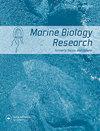基于全有丝分裂基因组的双髻鲨(锤头鲨科)系统发育定位和分子定年
IF 1.2
4区 生物学
Q4 ECOLOGY
引用次数: 0
摘要
由于持续的过度捕捞和人为变化,双髻鲨(锤头鲨目:锤头鲨科)在其大部分地理分布范围内急剧减少。由于这些鲨鱼的k选择生活史,它们的种群恢复力和持久性仍然严重紧张,进一步损害了生态系统的稳定性。此外,一些物种在很大程度上没有得到充分的研究,例如隐秘的同系物,卡罗莱纳双髻鲨(Sphyrna gilberti),而特定地区,如西南印度洋(SWIO),仍然相对缺乏数据,有可能最终灭绝独特的双髻鲨血统。本研究的目的是通过纳入代表性不足的物种序列,验证隐种S. gilberti在蛛科中的系统发育位置,为理解蛛科生物多样性的历史驱动因素提供更全面的系统发育视角。本研究描述了来自美国大西洋的隐型S. gilberti的第一个完整线粒体基因组,以及来自数据缺乏的西南印度洋(SWIO)的光滑双髻鲨(Sphyrna zygaena)和扇贝双髻鲨(Sphyrna lewini)样本的有丝分裂基因组。此外,我们利用线粒体蛋白编码(PCG)和rRNA基因估计了Sphyrnidae家族的系统发育相互关系,重申了S. gilberti作为S. lewini的姐妹谱系的位置。由此得出的系统发育估计进一步用于评估S. gilberti最可能首次出现的年龄,对应于中新世晚期至更新世早期(380万至1080万年前)。对这些双髻鲨在海洋盆地间的比较分析,以及对S. lewini和S. gilberti的初步分化估计,有助于解决全球双髻鲨系统发育问题。这为双髻鲨属的进化提供了独特的见解,从而有助于未来在更大的空间尺度上对双髻鲨种群进行有效的保护和管理。本文章由计算机程序翻译,如有差异,请以英文原文为准。
Phylogenetic placement and molecular dating of hammerhead sharks (Sphyrnidae) based on whole mitogenomes
ABSTRACT Due to continued overexploitation and anthropogenic change, hammerhead sharks (Carcharhiniformes: Sphyrnidae) have experienced drastic declines over most of their geographic range. Owing to the K-selected life histories of these sharks, their population resilience and persistence, remain severely strained, further compromising ecosystem stability. Moreover, some species are largely understudied e.g. the cryptic congener, the Carolina hammerhead shark (Sphyrna gilberti), whilst specific regions, such as the South-West Indian Ocean (SWIO), remain relatively devoid of data, risking the eventual extirpation of unique hammerhead shark lineages. The aim of the present study was to verify the phylogenetic placement of the cryptic S. gilberti within the family Sphyrnidae through the inclusion of underrepresented species sequences in order to provide a more comprehensive phylogenetic perspective for understanding historical drivers of Sphyrnidae biodiversity. The present study describes the first complete mitochondrial genome of the cryptic S. gilberti originating from the US Atlantic, as well as the mitogenomes of smooth hammerhead shark (Sphyrna zygaena) and scalloped hammerhead shark (Sphyrna lewini) samples originating from the data deficient South-West Indian Ocean (SWIO). Furthermore, we estimate the phylogenetic interrelationships of the Sphyrnidae family using mitochondrial protein-coding (PCG) and rRNA genes, reaffirming the placement of S. gilberti as a sister lineage to S. lewini. The resulting phylogenetic estimate is further used to evaluate the most likely age of the first occurrence of S. gilberti, corresponding to the Late Miocene to Early Pleiocene Epoch (3.8–10.8 million years ago). Comparative analysis of these Sphyrnids between ocean basins, as well as preliminary divergence estimates for S. lewini and S. gilberti has contributed towards resolving the global hammerhead phylogeny. This has provided unique insights into the evolution of the genus, thereby aiding future efforts directed towards effective conservation and management of hammerhead populations over a larger spatial scale.
求助全文
通过发布文献求助,成功后即可免费获取论文全文。
去求助
来源期刊

Marine Biology Research
生物-海洋与淡水生物学
CiteScore
2.10
自引率
0.00%
发文量
55
审稿时长
6-12 weeks
期刊介绍:
Marine Biology Research (MBRJ) provides a worldwide forum for key information, ideas and discussion on all areas of marine biology and biological oceanography. Founded in 2005 as a merger of two Scandinavian journals, Sarsia and Ophelia, MBRJ is based today at the Institute of Marine Research, Bergen, Norway. The Journal’s scope encompasses basic and applied research from all oceans and marine habitats and on all marine organisms, the main criterium for acceptance being quality.
 求助内容:
求助内容: 应助结果提醒方式:
应助结果提醒方式:


